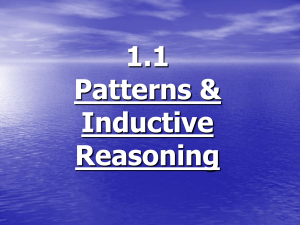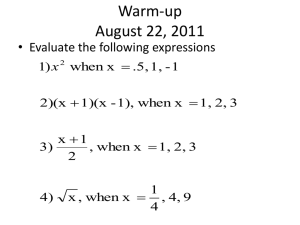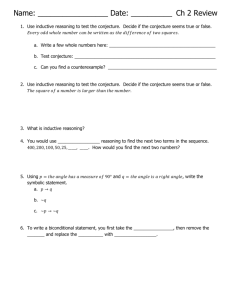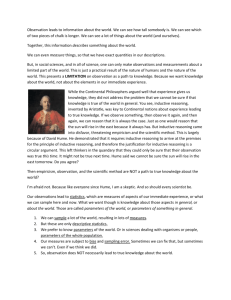1. - Anderson
advertisement
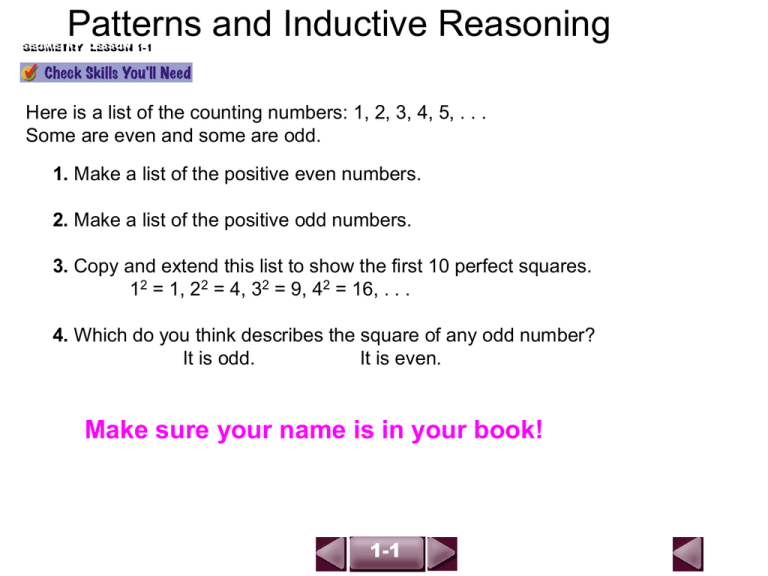
Patterns and Inductive Reasoning GEOMETRY LESSON 1-1 Here is a list of the counting numbers: 1, 2, 3, 4, 5, . . . Some are even and some are odd. 1. Make a list of the positive even numbers. 2. Make a list of the positive odd numbers. 3. Copy and extend this list to show the first 10 perfect squares. 12 = 1, 22 = 4, 32 = 9, 42 = 16, . . . 4. Which do you think describes the square of any odd number? It is odd. It is even. Make sure your name is in your book! 1-1 Patterns and Inductive Reasoning GEOMETRY LESSON 1-1 Solutions 1. Even numbers end in 0, 2, 4, 6, or 8: 2, 4, 6, 8, 10, 12, 14, 16, 18, 20, 22, 24, . . . 2. Odd numbers end in 1, 3, 5, 7, or 9: 1, 3, 5, 7, 9, 11, 13, 15, 17, 19, 21, 23, 25, . . . 3. 12 = (1)(1) = 1; 22 = (2)(2) = 4; 32 = (3)(3) = 9; 42 = (4)(4) = 16; 52 = (5)(5) = 25; 62 = (6)(6) = 36; 72 = (7)(7) = 49; 82 = (8)(8) = 64; 92 = (9)(9) = 81; 102 = (10)(10) = 100 4. The odd squares in Exercise 3 are all odd, so the square of any odd number is odd. 1-1 What is Geometry •Geometry is more than the study of shapes. It is the study of truths. •These truths are constant, no matter what the situation. •Geometry uses reason (logic) to prove truths and to build upon them to prove even more truths. •The study of geometry is a study of how to think logically. There are two types of logical strategies: 1. Inductive Reasoning 2. Deductive Reasoning Chapter 1 Section 1 • Goals: • Use inductive reasoning to make a conjecture. Vocabulary 1.1 •Inductive Reasoning •investigating using the observation of patterns •Conjecture •A conclusion reached based upon inductive observation •Counterexample •An example that shows the conjecture is not correct •Prime Number •A Positive number with no factors other than itself and 1. (The smallest prime number is 2.) Use Inductive Reasoning: GEOMETRY LESSON 1-1 Find a pattern for the sequence. Use the pattern to show the next two terms in the sequence. 384, 192, 96, 48, … # 384 192 96 48 24 ÷2 ÷2 1. Write the sequence 2. What value is +,-,x, or ÷ each time? ÷2 ÷2 ÷2 12 Each term is half the preceding term. So the next two terms are 1-1 48 ÷ 2 = 24 and 24 ÷ 2 = 12. Use Inductive Reasoning GEOMETRY LESSON 1-1 Make a conjecture about the sum of the cubes of the first 25 counting numbers. Find the first few sums. 13 13 + 23 13 + 23 + 33 13 + 23 + 33 + 43 13 + 23 + 33 + 43 + 53 =1 =9 = 36 = 100 = 225 = 12 = 32 = 62 = 102 = 152 = (1)2 = (1+2)2 = (1+2+3)2 = (1+2+3+4)2 = (1+2+3+4+5)2 The sum of the cubes equals the square of the sum of the counting numbers. 1-1 Use Inductive Reasoning GEOMETRY LESSON 1-1 The first three odd prime numbers are 3, 5, and 7. Make and test a conjecture about the fourth odd prime number. One pattern of the sequence is that each term equals the preceding term plus 2. So a possible conjecture is that the fourth prime number is 7 + 2 = 9. However, because 3 X 3 = 9 and 9 is not a prime number, this conjecture is false. By applying the assumed pattern and then testing the result against the initial directions, we have found a counterexample. A counterexample applies the presumed pattern and gives a false result. Only ONE counterexample is needed to prove a conjecture is false. Conjecture: odd prime numbers are found by adding 2 to each odd prime. Counterexample: 7 is odd prime, 7+2 = 9, 9 is not prime. Result: Conjecture is false. The fourth prime number is 11. 1-1 When points on a circle are joined, they produce unique regions within the circle: Points 2 3 4 5 6 Regions 2 4 8 16 ?? Will the # of regions always be twice as many as the previous number? 6 points yields 30 regions. 30 is NOT 2x16! Conjecture is false. Use Inductive Reasoning GEOMETRY LESSON 1-1 The price of overnight shipping was $8.00 in 2000, $9.50 in 2001, and $11.00 in 2002. Make a conjecture about the price in 2003. year 2000 2001 2002 2003 $$ 8.00 9.50 11.00 12.50 Write the data in a table. Find a pattern. + 1.50 + 1.50 + 1.50 Each year the price increased by $1.50. A possible conjecture is that the price in 2003 will increase by $1.50. If so, the price in 2003 would be $11.00 + $1.50 = $12.50. Re-Cap •Inductive Reasoning •Based upon observation of patterns •Conjecture •A conclusion reached based upon inductive observation •Counterexample •An example that shows the conjecture is not correct •Prime Number •Number with no factors other than itself and 1. Tips for Inductive Reasoning: •Make a list •Make a table when comparing two sets of numbers •Look for simple numbers patterns Additional Practice GEOMETRY LESSON 1-1 Find a pattern for each sequence. Use the pattern to show the next two terms or figures. Use the table and inductive reasoning. 1. 3, –6, 18, –72, 360 –2160; 15,120 2. 3. Find the sum of the first 10 counting numbers. 55 4. Find the sum of the first 1000 counting numbers. 500,500 Show that the conjecture is false by finding one counterexample. 5. The sum of two prime numbers is an even number. Sample: 2+3=5, and 5 is not even 1-1
